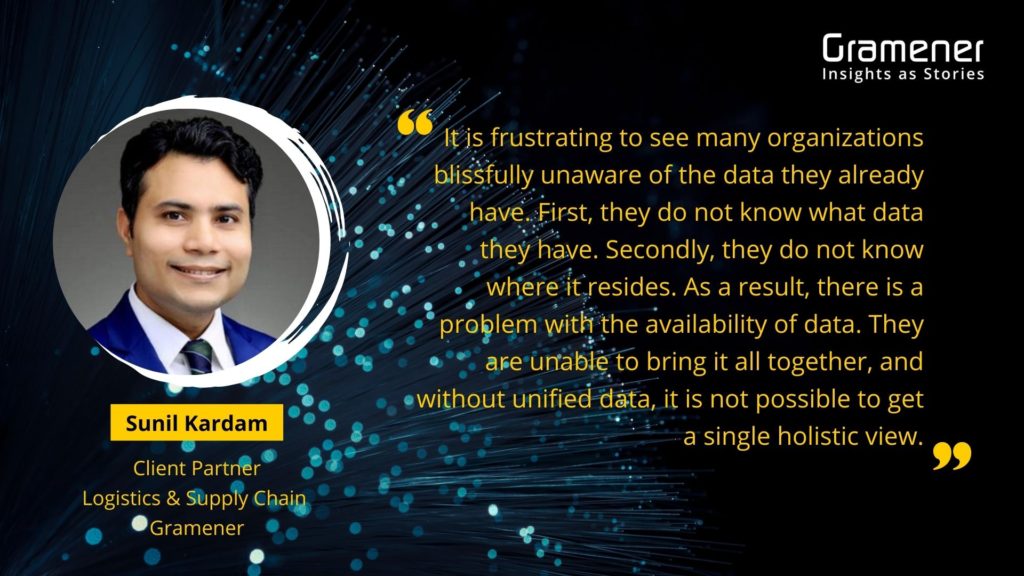Note: This is the 1st article in the 5-part “Supply Chain Data Strategy” series, a strategy to enlighten supply chain managers about the advantages of data-driven decision-making.
Precap: In this article, we will discuss the fundamentals of data science, as well as some data-driven supply chain strategies and how to get started with a plan.
Check out other parts of the series:
- Why you need supply chain data strategy (Part 2)
- When to implement a supply chain data strategy (Part 3)
- 6 unsolicited tips to build the best supply chain data strategy (Part 4)
- How to implement your supply chain data strategy (Part 5)
The data flowing in from the supply chain of an organization grows exponentially. Your organization may have adopted advanced technology solutions that generate voluminous data. To leverage the value of this data, you need a supply chain data strategy.
Enterprise Resource Planning (ERP) and Supply Chain Management (SCM) platforms throw up data on sourcing, inventory, manufacturing, warehousing, transportation, and point of sale.
You can optimize your supply chain if you know how to interpret this data, recognize patterns, identify trends, analyze changes, and develop insights. For this, you need to implement a supply chain data strategy. By implementing a robust supply chain data strategy and roadmap you can also get rid of complex supply chain bottlenecks.
A supply chain data strategy is a well-laid-out plan to improve supply chain performance and efficiency. It is based on data findings from each point of production, and the insights gained can be used to serve business priorities. Data transparency and security is the key to building trust in the supply chains. These are essential ingredients that make up the supply chain visibility
Once you have clarity on the data you need to drive business growth, you can tap several traditional or modern sources. Aggregating real-time data to ensure visibility across the supply chain is the backbone of a robust supply chain data strategy.

Table of Contents
Harnessing Data in Supply Chain Management
It is important to collate relevant and high-quality data across a wide range of sources to leverage supply chain data. For instance,
Traditional data sources that include internal and structured data from:
- Software solution platforms: ERP, SCM, Product Lifecycle Management, e-Sourcing, Customer Relationship Management
- Cloud Storage: Private, public, community, hybrid
- Databases: SQL, NoSQL, Blockchain
- Proprietary or in-house data algorithms and tools
Non-traditional sources that include external and unstructured big data from:
- Internet: Social media, clickstreams, audio, video, and images
- Cognitive Computing: Sentiment analysis, risk assessment, and fraud detection
- Artificial Intelligence: Natural Language Processing, Machine Learning, and Digital Twin
- Internet of Things: Mobile sensors, RFID chips, and smart devices
As data streams expand, Gartner has predicted that by 2025, the most exchanged supply chain data will be about supply chain risk and disruption.
The challenge for the chief supply chain officer is not just to collect new datasets but to respond with agility to the intelligence it brings. It means you need to make split-second decisions to mitigate risks. Click To TweetThe task is to execute decisions in real-time and make investments that enable you to act in real-time. This capability can only come from adopting a data-driven supply chain strategy.
Data-Driven Supply Chain Strategy
A data-driven supply chain strategy is nothing but an enterprise-wide framework for utilizing data for long-term business goals. It is backed by a clearly enunciated vision, mission statements, and annual plans. In addition, it also requires properly articulating the role of data solutions in the design, plan, monitoring, and execution of supply chain data strategy.
Supply Chain Design
Elaborates on the structure, network, location, inputs, and processes linked to the supply chain points to ensure smooth physical, information, and financial flow. It lists strategic objectives like demand forecasting, establishing supplies, planning, and scheduling manufacturing operations. Most importantly, it charts the data initiatives needed to ensure end-to-end visibility and foster product innovation.
Supply Chain Planning
Includes a series of plans for supply chain deployment, inventory, coordination of assets, balancing supply and demand, and monitoring to optimize the delivery of goods, services, and information from source to consumer. It provides real-time access to data that supports business decisions like dynamic pricing, routing, and inventory replenishment. A plan for suitable track-and-trace processes is also a must.
Supply Chain Execution
Involves putting the plans to action with applications, management systems, and data solutions. When followed up with an advanced and comprehensive supply chain analytics strategy, it helps to predict risks and manage disruptions safeguarding business interests.
It is quite evident that a sound supply chain data strategy can positively impact various stages of supply chain operations – planning, sourcing, making, and delivering.
Adopting a well-crafted supply chain data strategy and road map can be the first step to a supply chain that aligns with business goals.
Find out how the tremendous benefits of AI in supply chain can help your businesses outperform the competition by decreasing costs and optimizing operations.
Expert’s View: Data is Everywhere, but What About Insights?

“I have seen that most organizations invest in data, but not all can extract value from it. It has become a fad to claim that an organization is data-driven, but of what use is that data if it resides in departmental silos, rarely interacting, not analyzed, and indeed never interpreted for business insights?
Another frequent problem is that while a company may have collated massive amounts of data, it is of little use as it is of inferior quality.
I have seen instances where ‘implanted’ data adulterates the data repository. This happens when there is no data culture in the company. Installing a range of data applications does not help to cultivate a data mindset.
There is a dearth of data talent – a must when collecting, collating, and analyzing data for its true value. If data is required for, say, a month or more, and they have not collected or been able to pull it out from the source, they adopt short-cut methods of inputting false values.
This corrupts data streams and compromises data quality, amounting to forgery. It is then meaningless to try and derive beneficial insights from such data.
So, while an organization must put a holistic data science strategy in place, it is even more important to ensure a strong data governance framework.”
Contact us for custom built low code data and AI solutions for your business challenges and check out supply chain AI solutions built for our clients, including Fortune 500 companies. Book a free demo right now.
Read More: Find out why you need supply chain data strategy in the 2nd part of this series.

